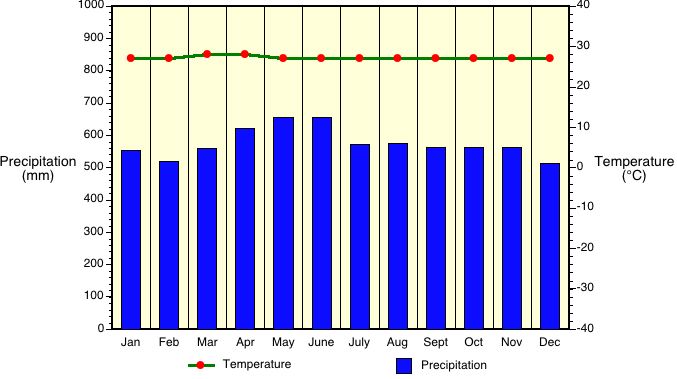1. What is the difference between weather and climate?
a. Weather describes precipitation and wind while Climate describes global pressure and temperature.
b. Weather describes the long-term trend in atmospheric conditions while Climate describes the short-term trends.
c. Weather describes the short-term trends in atmospheric conditions while Climate describes the long-term trends.
d. Climate describes the effects of atmospheric conditions on land while Weather describes the actual atmosphere.
e. None of the above.
2. How would climate vary on a global scale if there were no continents?
3. The Koppen climate classification scheme uses what variables to describe differences in climate?
a. temperature c. precipitation e. both a and c
b. pressure d. wind
4. BS and BW climates can typically be found on the windward sides of mountains and in the 30 degree latitudes.
a. TRUE b. FALSE
Questions 5-7 refer to the following diagram:

5. What climate is represented by the above graph?
a. Csa c. Af e. Aw
b. BWh d. As
6. Which statement is TRUE regarding the above climate?
a. Precipitation exceeds PET c. Outputs of moisture exceed inputs
b. PET exceeds Precipitation d. Temperature is greater than Precipitation
7. The above illustrated climate would most likely be found...
a. in Europe. c. in Brazil. e. None of these.
b. in Canada. d. in Texas.
8. Evapotranspiration is....
a. an input of moisture to an ecosystem. c. transpiration and evaporation. e. none of the above.
b. not influenced by plants. d. both b and c.
9. Photosynthesis is the process by which plants take in oxygen and produce carbon dioxide and water.
a. TRUE b. FALSE
10. In a BWh climate, which of the following plants would be native?
a. Conifer Tree c. Saguaro Cactus
b. Banana Tree d. Broad-leafed Deciduous Tree
THE BIOSPHERE QUESTIONS
1. Which of the following is NOT a component of the Biosphere?
a. Mid-latitude Forest c. Rainbow Trout e. None of the Above, all are components
b. Manzanita plant d. Insects
2. In a Cfa climate, which vegetation class would you expect to find?
a. Boreal Forest c. Desert e. Tropical Rainforest
b. Mid-latitude Forest d. Mid-latitude Grassland
3. The density of vegetation growth is greater for a Tropical Rainforest than a Mid-latitude forest.
a. TRUE b. FALSE
4. Vegetation growth in a Tropical Rainforest is....
a. one tiered. c. three tiered e. five tiered
b. two tiered. d. four tiered.
5. How have vegetation growing in deserts adapted to dry conditions?
a. smaller leaves c. more extensive roots e. all of the above
b. less leaves d. no leaves at all
6. As you travel poleward from the equator, how will the vegetation growth change in terms of height,
density of plants, density of growth, etc. ?
Questions 7-10 refer to the following 2 pictures


These pictures were taken in Colorado at approximately 40º N latitude.
7. In the top photo, what vegetation class is shown?
a. Mid-latitude Grassland c. Tundra e. None of the Above
b. Savanna d. Desert
8. In the lower photo, why are the trees only growing in one spot?
9. In the lower photo, the trees in the center of the photo are part of what vegetation class?
a. Mid-latitude Forest c. Tropical Deciduous Forest
b. Tropical Rainforest d. Conifer Forest
10. Are these two vegetation classes what you would expect to find at the 40º N latitudes?
If not, then why are they present here?

8800 Grossmont College Drive
El Cajon, California 92020
619-644-7000
Accessibility
Social Media Accounts